AMD's A10-5750M Review, Part 2: The MSI GX60 Gaming Notebook
by Dustin Sklavos on June 29, 2013 12:00 PM ESTDisplay Quality
High dpi displays, even if they're TN panels, tend to perform fairly well, and the 1080p 15.6" panel on the MSI GX60 is at least a healthy one. I feel like at long last we're finally starting to come out of the dark ages of 1366x768 panels; virtually none of the notebooks I've tested recently have had bad or low-resolution panels. With tablets pushing pixel density ever higher and TN panels only showing up on the cheapest of the cheap, the notebook industry has been running out of excuses to fob crappy displays on us. You'll still see them at the lowest and most mainstream price points, but the trickle-down mercifully seems to have begun.
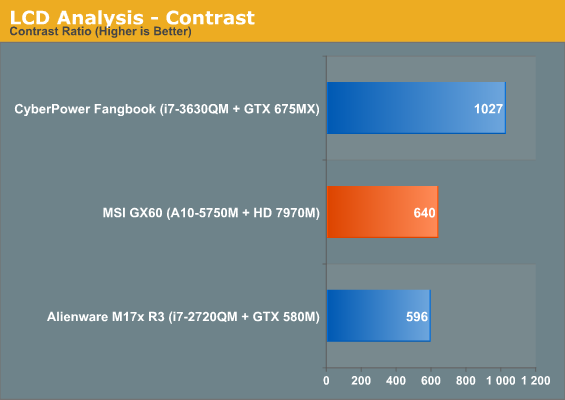
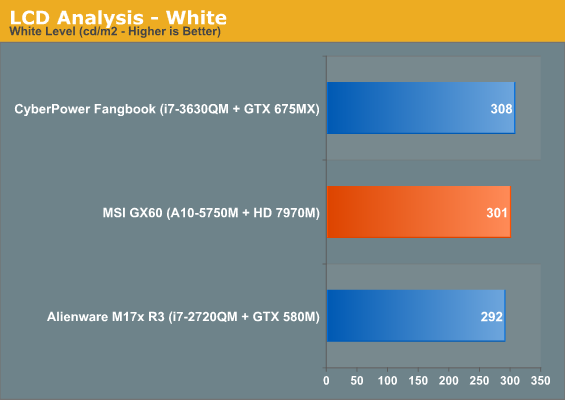
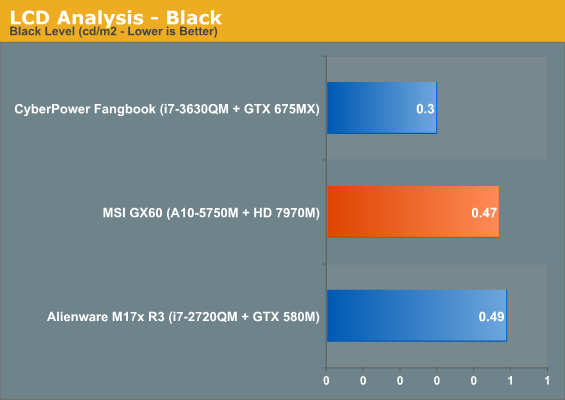
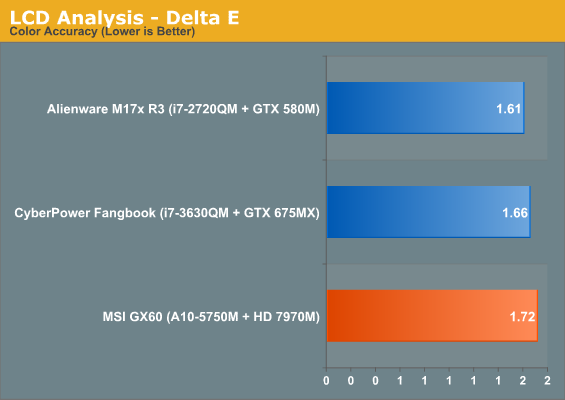
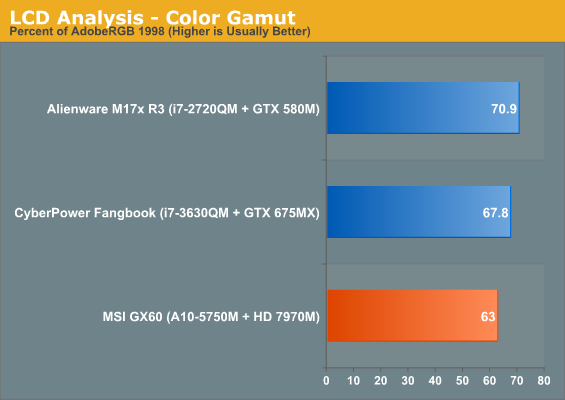

The panel MSI uses for the GX60 isn't exemplary, but the contrast ratio is a far cry from the sub-300 or even occasional sub-200 TN panels of the entry level market. If nothing else, the 1080p display is more than adequate for both gaming and any basic work, and I appreciate that MSI has stuck with the trend in the gaming notebook market of moving towards matte panels. Alienware was the last holdout, but their refreshed line of notebooks doesn't feature glossy displays either.
Battery Life
Unfortunately, perhaps frustratingly, we weren't able to get battery running time results for the original Trinity-based GX60, so MSI's new Richland-based model is stuck in the wilderness. Jarred has also reported continued issues with AMD's Enduro technology, but my experience with it on the GX60 was actually pretty painless. Enduro's interface is still miles behind NVIDIA's Optimus, but I at least have hope now that AMD will be able to compete and level the playing field. As it stands, NVIDIA hardware has been ubiquitous in the notebook space. While that's good for them, consumers need choice and competition.

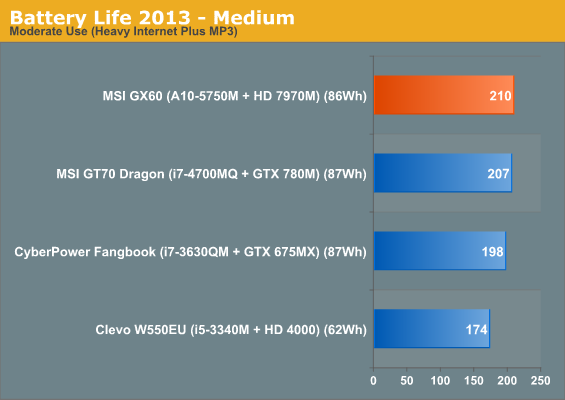
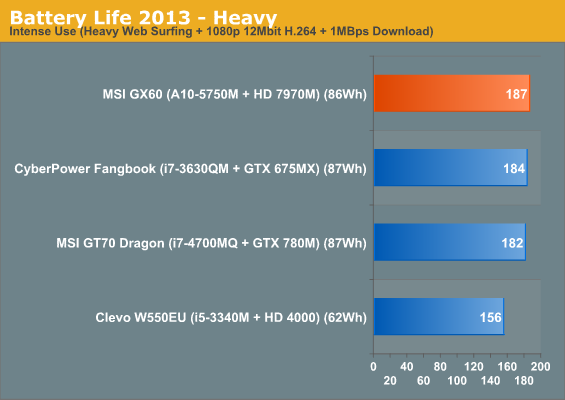
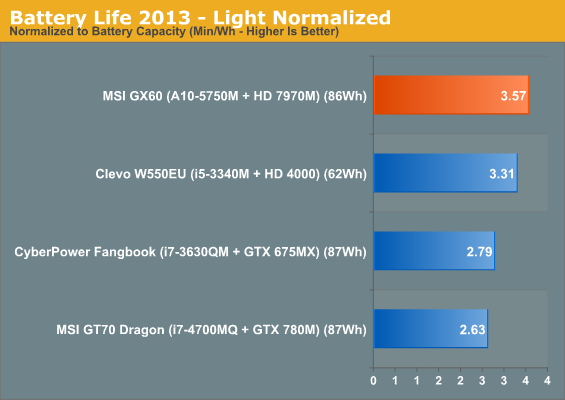
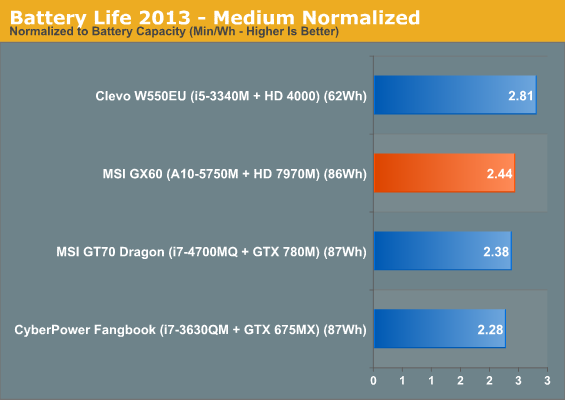
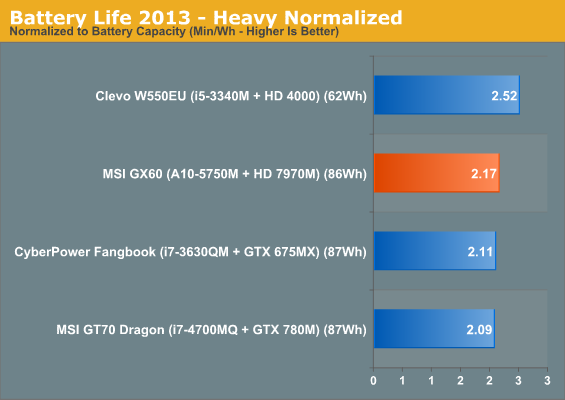
Compared to the other gaming notebooks tested and even the lone Clevo ultrabook, the MSI GX60 is able to actually produce pretty excellent battery life. If all you're doing is casually surfing the internet, the Richland-based APU powering the GX60 can give you a solid five hours of running time.
Heat
While the larger GT70 Dragon Edition had trouble managing its thermals (hopefully fixed with a BIOS update, more on this to come soon), the GX60's dealing with a much lower thermal load. The Intel Core i7-4700MQ coupled with the GeForce GTX 780M results in a peak power draw of almost 150W between the CPU and GPU, while the GX60 tops out at 110W.

I'm not sure what HWMonitor is reading as the "package" temperature, but I can tell you that's not what the APU is running at. For a better idea of how hot the system is running, take a look at the "THRM" value and the temperature value under the Radeon. The GX60 has no trouble dissipating the heat from the A10-5750M and Radeon HD 7970M.










69 Comments
View All Comments
TheinsanegamerN - Saturday, June 29, 2013 - link
2 minutes? pretty good for that generationcoolhardware - Saturday, June 29, 2013 - link
Thank you for including SC2 gaming benchmarks! As I am trying to decide on an ideal system for SC2 (without being overkill), your results are very helpful to me in determining how important CPU performance is versus GPU performance. Thanks again :-)sheh - Saturday, June 29, 2013 - link
When will i5-4xxxM start coming the market?The Intel Haswell announcement at the beginning month had me thinking it's out any day, but so far there are only i7s and U series CPUs, and no real info anywhere on the i5 Ms.
JarredWalton - Saturday, June 29, 2013 - link
I expect we won't see the dual-core standard voltage Haswell chips for at least another month or two -- same thing happened with Ivy Bridge and Sandy Bridge, except we got SV before we got ULV. Now Intel is pushing ULV hard, so they launched those chips at the same time as the QC SV and desktop QC parts.sheh - Saturday, June 29, 2013 - link
Thanks. Well, that's a crying shame. Looks I'll have to settle for an Ivy Bridge.Dustin Sklavos - Sunday, June 30, 2013 - link
No shame in that, Ivy is still a damn fine chip. Haswell is incremental.FwFred - Sunday, June 30, 2013 - link
Incremental for laptops? Do you carry your power cord everywhere?silverblue - Sunday, June 30, 2013 - link
I'd argue that Haswell is far more important in the mobile arena than it ever would be on the desktop. Still, is the difference actually that dramatic?JarredWalton - Sunday, June 30, 2013 - link
It's a big difference if you need, say, 8-10 hours of battery life instead of 6-8. Otherwise, it's not that big of a deal. I rarely go unplugged for more than a few hours, so I can easily live with the lower battery life of IVB.sheh - Sunday, June 30, 2013 - link
HD 4600 is no 5xxx, but still a noticeable update from 4000. And battery time does matter to me. I suppose it'll also go easier on the battery recharge cycles.